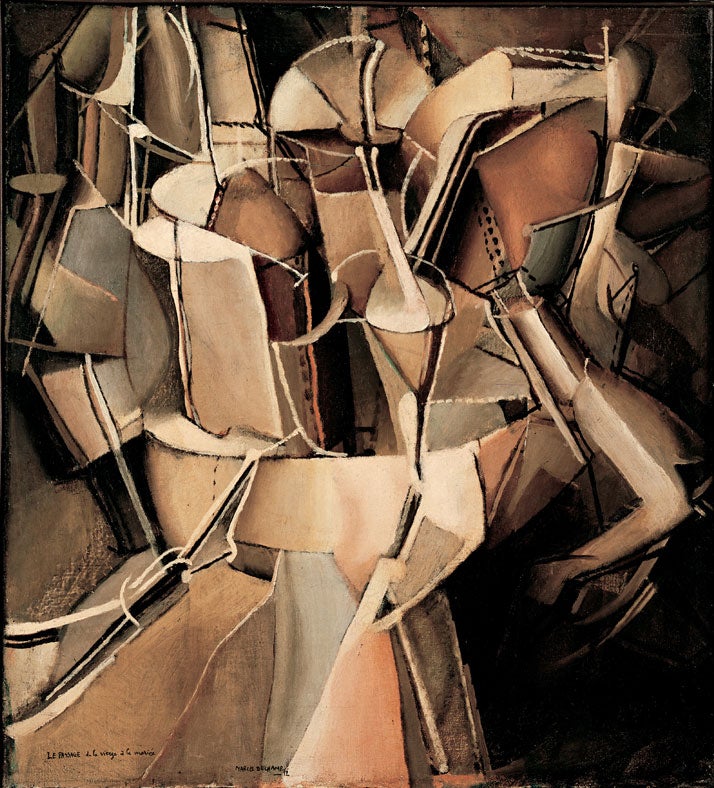Duchamp, Marcel: The Passage from Virgin to Bride (1912)
The Independent's Great Art series

Also in this article: About the artist
There is nonsense writing and there's nonsense painting, too. The first verse of Lewis Carroll's "Jabberwocky" goes: "'Twas brillig, and the slithy toves / Did gyre and gimble in the wabe; / All mimsy were the borogoves / And the mome raths outgrabe." We call this nonsense verse, but it doesn't make no sense. Some of its words are invented, but more than half of them are very basic English words. And they're strung along with the nonsense words in a way that conveys a standard syntax.
A scene is being described. We can mostly tell whether each nonsense word is a noun, a verb or an adjective. We even have an inkling of what they might specifically mean. Brillig sounds bright and chilly.
There are moments, though, where the verse goes into free fall. In the last line, the syntax is all up for grabs. Mome raths outgrabe: which of these words is a noun, a verb, an adjective or adverb? It's really up to you, for there are several possible readings. But you can also read that line without making any definite decisions. You can just accept it, with a feeling that, while a meaning does lurk somewhere within the words, it remains mysteriously beyond our grasp. That feeling is the real pleasure of nonsense.
Marcel Duchamp's The Passage from Virgin to Bride is usually called a picture about sex and machines. It implies that machines are sexual. It implies that sex is mechanical. And so it does. But a picture, if it wanted to, could do both those things much more clearly, directly and unmysteriously. And the point about this early Duchamp picture is that it doesn't. It is a kind of a nonsense painting.
Like "Jabberwocky", it doesn't make sense but it doesn't make no sense, either. It would be wrong to call it abstract, or even semi-abstract, because those terms suggest an image that's sorted itself out. This image is inherently teasing. You can't help trying, and failing, to grasp it.
Set aside the interesting title. Imagine the picture at a distance. Even before you recognise any particular thing, you have a sense of thinginess. You distinguish solid forms from surrounding space. You see a cluster of separate elements.
There is directional lighting. The surfaces and edges of things catch the light, and other surfaces fall into shadow. The whole cluster stands out from a dark background. The picture, in other words, has a clear representational "syntax", and this raises an expectation that it will represent something.
It almost does. Its forms do look like known things. They resemble engine parts or lab equipment. You can pick out tubes, funnels, pistons, pipes. You see not only a cluster, but a complex connective system.
The forms are not wholly mechanical, though. They're anatomical, too. They intimate tendons, veins, tissue, ganglia. This might be a nervous, circulatory or digestive system. Meanwhile, some of the arcing lines and dotted lines suggest a diagram, rather than a picture, with lines that indicate moving parts, flows of energy.
But for all that we perceive edges and surfaces, light and shadow, none of the elements are fully solid or distinct. They interpenetrate, dematerialise and dissolve. The system is in delicate meltdown. And recalling the title, you may take this as depicting a transformation, as if we saw something unfolding in mid-metamorphosis, or with several successive stages superimposed.
Even so, in The Passage from Virgin to Bride, you can't tell what is turning into what, or say which bit is Virgin, which Bride. You have only hints. You have thinginess with no definable objects. You have a process involving no identifiable subject. You can't abandon the idea that something is meant, something is happening, but you have to accept that you can't articulate it. The mome raths outgrabe.
The artist
Marcel Duchamp (1887-1968) has been transformed. In his lifetime he was mainly seen as an arch-wag, who devised some clever anarchic gestures like exhibiting a urinal as an artwork and then gave up art to play chess. In recent decades he has turned into the most influential artist of the 20th century, the father of conceptualism. What tends to get lost between these two views is the fact that Duchamp was a good artist: not only an ideas man, but a great exponent of making. You can see a wide selection of his pictures, found objects, gadgets, optical devices and constructions, including this painting, in Duchamp, Man Ray, Picabia at Tate Modern.
Join our commenting forum
Join thought-provoking conversations, follow other Independent readers and see their replies
Comments
Bookmark popover
Removed from bookmarks